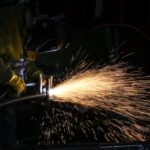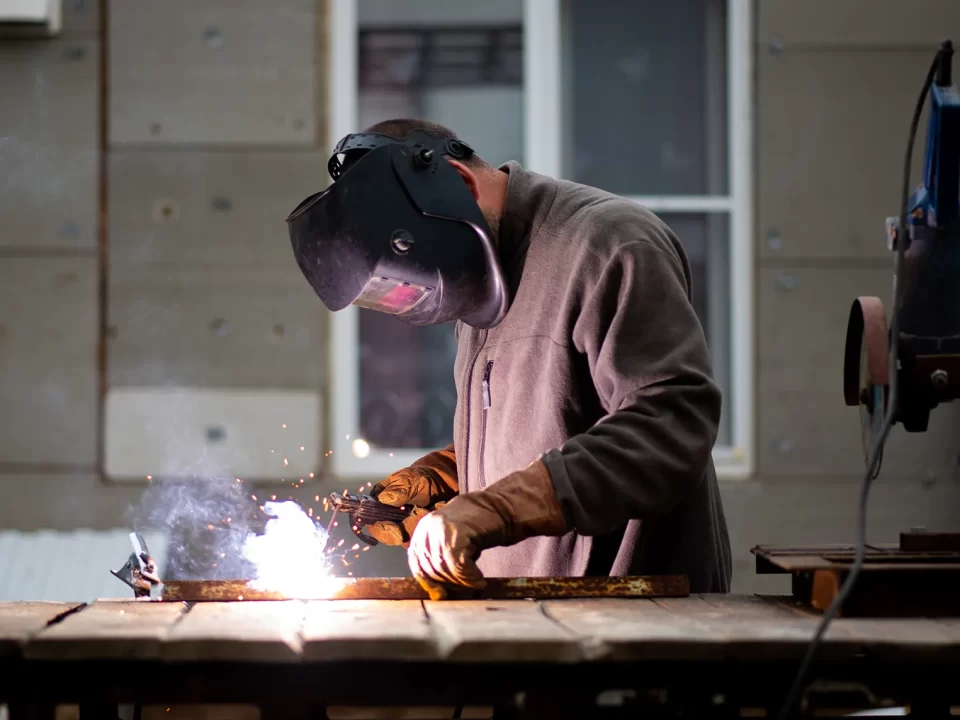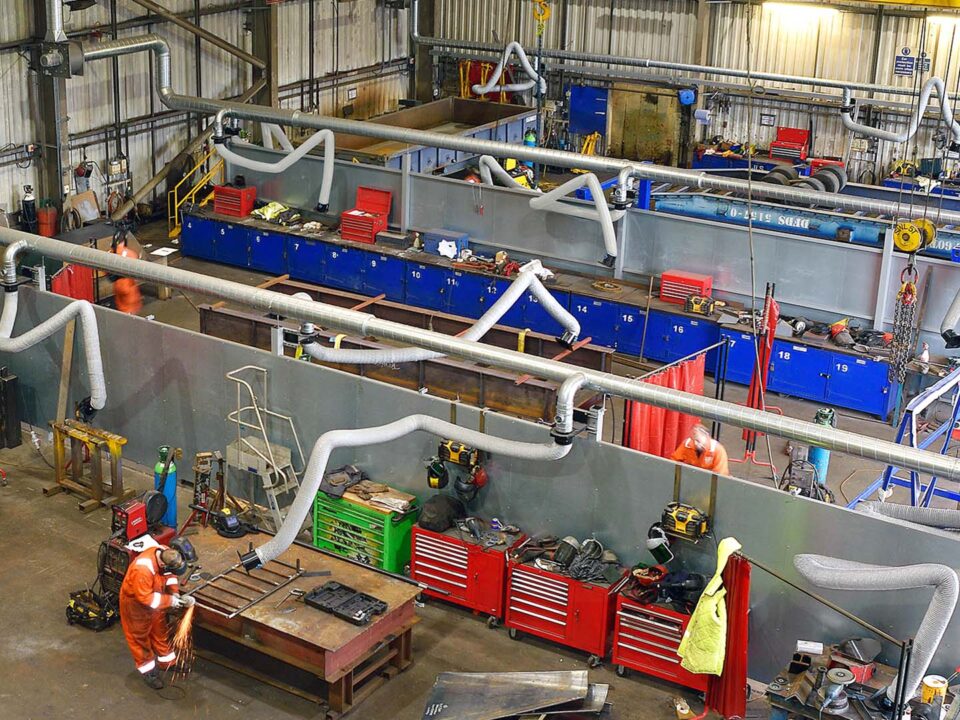
Should I Buy of Rent Welding Machine
February 8, 2023
Understanding Robot Welding Machines: A Complete Guide
February 14, 2023Definition and Purpose
Welding is a commonly used method for joining metal parts together, but it can also produce fumes and particulate matter that can be harmful to human health and the environment.
To mitigate these risks, welding fume extractors are utilized. A welding fume extractor is a device that is designed to capture and remove fumes produced during welding processes, thereby creating a cleaner, safer work environment.
Welding fumes are a mixture of tiny particles, gases, and vapours that can be inhaled into the lungs, causing health problems such as irritation, respiratory issues, and even long-term damage.
In addition, welding fumes can also contaminate surfaces and equipment, leading to additional cleaning costs. By using a welding fume extractor, these risks are reduced and the workplace remains cleaner, safer, and healthier for workers.
The design of welding fume extractors varies but typically includes a hood or nozzle to direct the fumes into the unit, a filtration system to capture particles, and an exhaust system to remove the cleaned air.
Some welding fume extractors are portable and can be moved from one location to another, while others are designed for permanent installation in a central location.
In conclusion, a welding fume extractor is an essential tool for any workplace where welding is performed. It helps to reduce the risk of health problems associated with welding fumes, as well as ensuring a cleaner and safer work environment.
By investing in a welding fume extractor, companies can demonstrate their commitment to the well-being of their employees and the environment.

Components of a Welding Fume Extractor
A welding fume extractor typically has three main components, each serving a specific purpose:
1. Hood or Nozzle
The hood or nozzle is the part of the extractor that is positioned close to the welding source. Its function is to capture the fumes and direct them into the extractor.
The hood or nozzle is typically adjustable to accommodate different welding techniques and to ensure that fumes are captured effectively.
2. Filtration System
The filtration system is responsible for removing particulate matter from the air that is captured by the hood or nozzle.
The system may include one or more filters, such as HEPA filters, activated carbon filters, or a combination of the two. The type of filter used will depend on the specific requirements of the workplace and the type of fumes being generated.
3. Exhaust System
The exhaust system is responsible for removing the cleaned air from the extractor and returning it to the workplace. The system typically includes a fan that provides the necessary airflow, as well as ductwork to direct the cleaned air back into the workplace.
The exhaust system is designed to operate quietly and efficiently, minimizing any disruption to the work environment.
Together, these components work to create a cleaner, safer work environment by removing harmful particulate matter and fumes from the air.
The performance of a welding fume extractor depends on the design of the hood or nozzle, the efficiency of the filtration system, and the effectiveness of the exhaust system.
It is important to choose a welding fume extractor that is appropriate for the specific needs of the workplace and to maintain it regularly to ensure it continues to perform effectively.

Advantages of Using a Welding Fume Extractor
There are several advantages to using a welding fume extractor in the workplace:
1. Improved Air Quality
Welding fumes can have a negative impact on air quality, causing unpleasant odors and potentially harmful particulate matter.
By removing these fumes and particulate matter, a welding fume extractor helps to improve air quality, making the workplace a more pleasant and comfortable environment.
2. Health and Safety Benefits
Welding fumes can cause health problems such as irritation, respiratory issues, and long-term damage. By using a welding fume extractor, these risks are reduced, providing a safer working environment for employees.
3. Increased Productivity
Welding fumes can cause distractions and discomfort, reducing the productivity of workers. By removing these fumes, a welding fume extractor helps to create a more focused and productive work environment.
4. Cost Savings
Welding fumes can also cause contamination of surfaces and equipment, leading to additional cleaning costs. By reducing the amount of fumes generated, a welding fume extractor can help to minimize these costs.
In conclusion, using a welding fume extractor provides a range of benefits, including improved air quality, increased health and safety, increased productivity, and cost savings.
By investing in a welding fume extractor, companies can demonstrate their commitment to the well-being of their employees and the environment.

Factors to Consider When Choosing a Welding Fume Extractor
When choosing a welding fume extractor, there are several key factors to consider to ensure that the unit will meet the specific needs of the workplace:
1. Type of Welding
Different welding techniques generate different types of fumes, so it is important to choose a welding fume extractor that is appropriate for the type of welding being performed. For example, a unit designed for MIG welding may not be suitable for TIG welding.
2. Size of the Work Area
The size of the work area will determine the size and capacity of the welding fume extractor that is required. A larger work area will require a larger extractor, while a smaller work area may only require a portable unit.
3. Volume of Fumes
The volume of fumes generated during welding will also impact the choice of welding fume extractor. A unit with a larger capacity will be required if a large volume of fumes is generated, while a smaller unit may be sufficient if the volume of fumes is low.
4. Cost
Welding fume extractors can vary widely in price, so it is important to consider the cost when making a decision. While a more expensive unit may have more features and better performance, a less expensive unit may be more suitable for a smaller work area.
5. Maintenance Requirements
Welding fume extractors require regular maintenance to ensure that they continue to perform effectively. The maintenance requirements of the unit should be considered when making a decision, as well as the availability of replacement parts and filters.
6. Noise Level
Welding fume extractors typically produce some noise, which can be disruptive in a work environment. The noise level of the unit should be considered, particularly if it will be located in a noisy work area.
By considering these key factors, it is possible to choose a welding fume extractor that is appropriate for the specific needs of the workplace and that will provide effective and efficient performance.
Conclusion
In conclusion, welding fume extractors play a critical role in improving the air quality and safety of welding environments. By removing harmful fumes and particulate matter, welding fume extractors provide a cleaner and safer working environment for employees.
When choosing a welding fume extractor, it is important to consider factors such as the type of welding being performed, the size of the work area, the volume of fumes generated, cost, maintenance requirements, and noise level.
By carefully evaluating these factors, it is possible to select a welding fume extractor that meets the specific needs of the workplace and provides effective and efficient performance.
Investing in a welding fume extractor is an important step towards demonstrating a commitment to employee well-being and a healthier work environment.




